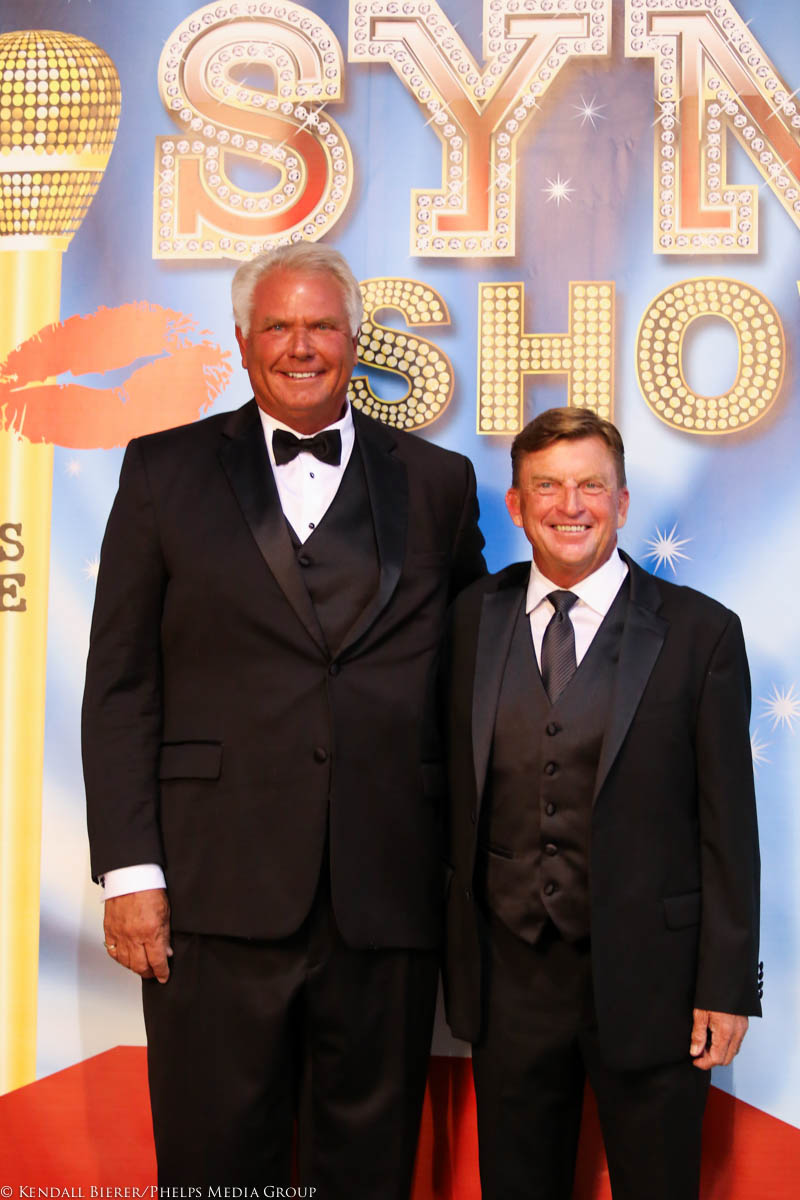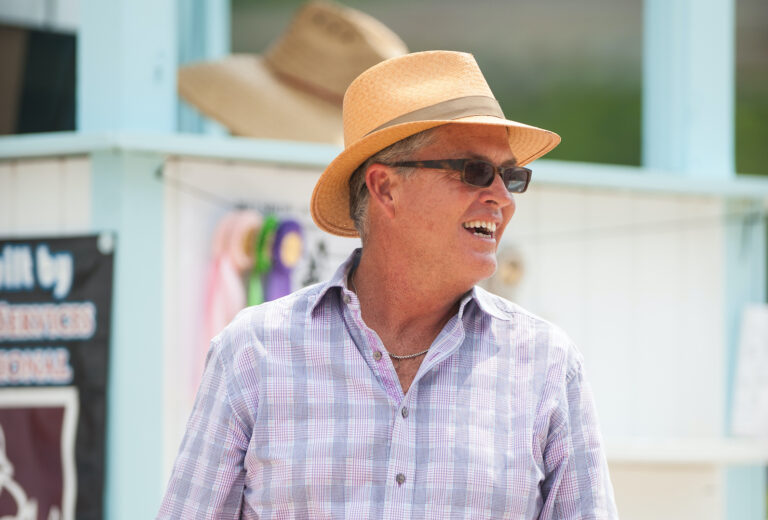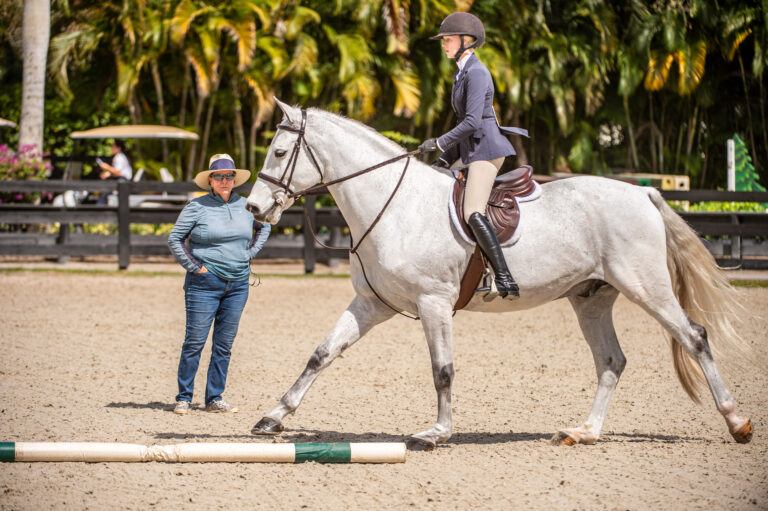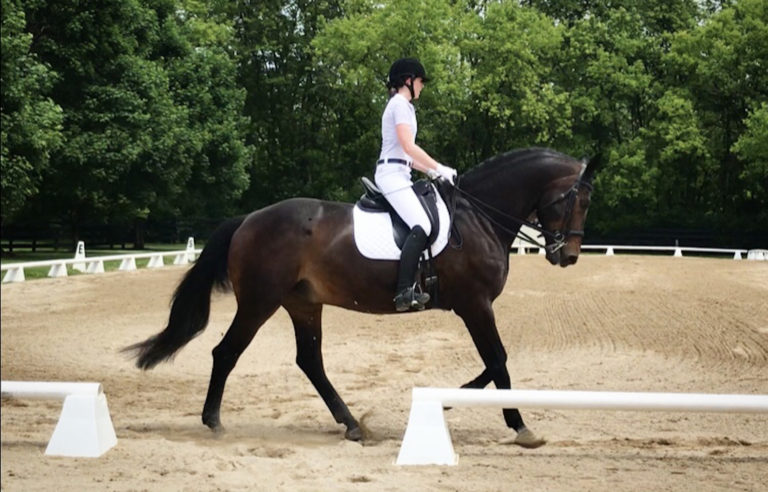
It was inevitable that horses would be part of Ron Danta’s life. He grew up in a very horsey neighborhood outside of Chicago, was riding ponies by age 7 and progressed from Pony Club and 4-H to showing on the Illinois hunter/jumper circuit in the 1960s.
Ron attended a local community college to appease his parents, who knew he was good with numbers. “I never intended to be an accountant,” he admitted. “I always knew I would end up working with animals.” While studying, he taught at a local barn, then rented his own place and built a roster of clients. When several barns collapsed in a huge snowstorm in 1978, Ron headed south. He eventually landed in Camden, South Carolina, merging his training business with Danny Robertshaw, a hunter trainer/judge and now Ron’s partner of 25 years.
Several horses that Ron trained were USEF Horse of the Year, and he’s won over 20 hunter championships at top A-rated shows. He chairs the task forces for the USHJA International Hunter Derby and the Green Incentive Hunter Derby and sits on the USHJA Hunter Working Group. The Chronicle of the Horse named Ron Horseman of the Year in 2013.
Despite his professional success, Ron may be best known as co-founder of Danny & Ron’s Rescue, a 501c3 charity that rescues and rehomes more than 900 dogs a year. In 2008, he and Danny were honored by the ASPCA as Honorees of the Year. At their Beaver River Farm in Camden, Ron and Danny live in a small house filled with rescue dogs and “not a lot of space for humans.”

PH: How did Danny & Ron’s Rescue get started?
RD: Danny and I were always going to animal shelters and greyhound kennels in Florida to try to find homes for dogs. Then when Hurricane Katrina hit in August 2005, we became aware of the thousands of dogs that were pulled out of the floodwaters but then put in crates in warehouses. The state didn’t have the staff to take care of them. So we sent a horse trailer down and got the first 25–30 dogs. We ended up taking more than 600.
That fall we loaded an extra trailer and brought dogs to Harrisburg for the Pennsylvania National Horse Show. We adopted out 50 dogs at that show. People were so generous in wanting to help. Horsepeople are animal lovers—I don’t think we would have the success that we have if it were not for our horse community.
In the beginning, we were just drawing money out of our retirement fund, but then we formed Danny & Ron’s Rescue as a 501c3. We just jumped in and never looked back.
PH: How is your rescue operation unique?
RD: We learned that abused or scared dogs need to be in a home atmosphere to learn what love is. People adopt friendly dogs that wag. Dogs that look petrified never get adopted.
We found that if we brought them into our house with lots of other dogs, the pack mentality helped. For weeks, a scared dog may stay behind the couch. But sooner or later he’d come out, then make it to the kitchen then onto the bed. It works. So now we average between 50 to 70 dogs living with us. The house is immaculate—we clean house twice a day, we do 19 loads of wash a day in our commercial washer, the dogs are bathed every week. It’s quite an operation.
PH: The flow of dogs that need homes seems to be endless. Why is that?
RD: It goes back to our laws and legislation. We have a lot of overbreeding—the puppy mills are a very large problem. And most shelters in the U.S. are full of pit bulls or pit bull mixes. It’s estimated that only one in 600 pit bulls will ever find a loving forever home. Most people don’t realize that dog fighting is a major problem in the big cities. The average purse is $50,000 and that world is rife with illegal drugs and firearms. The dog-fighting rings promote the breeding of pit bulls—they also pay crack dealers $50 to steal smaller animals as bait dogs. It’s a horrible situation.
The government needs to better control the breeding of pit bulls. We also need to have mandatory spay/neuter laws unless you have a breeder’s license. We still euthanize over 1.3 million dogs every year. It’s sad that in this day and age human beings aren’t smarter than this.
PH: Has your involvement in rescue changed you as a person?
RD: It has taught me to be less selfish because there is very little time for myself now. When I have worked 16 hours a day at the barn and trained the horses, then come home and take care of 75 dogs, medicate them and put them to bed, then get up in the morning and do it all again—it can make life challenging. But it has made Danny and I both better people for it. We definitely have to keep giving and not think much about ourselves.
PH: How did you become involved in horse rescue?
RD: Danny and I do that work personally, outside the 501c3. We get contacted by people we know about horses in trouble. Years ago, a lady in Kansas City had 21 horses who were starving. We hired vets and got them shots and Coggins. Then hunter/jumper trainer Daniel Geitner from Aiken, South Carolina, graciously let us use his 18-horse trailer and got a driver to get them out. Three of the horses had to be euthanized because they were in too bad of shape to ship. Most horses we rescue come from Amish Country. The largest kill lot in the U.S. is in Lancaster, Pennsylvania. We currently have 15 horses at the farm who have been saved.
PH: How do horses usually end up at a kill lot?
RD: There are just too many horses and not enough homes. The Thoroughbred racing industry contributes to this. Kill buyers are very prevalent at the track and most of those horses who can’t run or that break down end up at a kill lot. Also, the kill buyers watch newspapers and Craigslist. There are a lot of people who have starving horses that they can’t afford to feed anymore, so they let them go. It’s sad. The kill buyers sell them for a price per pound.
Horses arrive there for many reasons, but it’s a horrible end for each of them. When the horses get to these huge lots they are terrified. They are jammed into big cattle trucks, 30-wheelers, and driven under terrible conditions to Mexico or Canada, where they are slaughtered for their meat.
PH: How does this situation relate to show horses?
RD: A lot of show horses get donated because people want a big tax write-off. The horses are no longer sound and can’t do their job. I don’t know if people know this, but many of them eventually end up at the kill lot. It is pretty sad when we rescue these horses and find out from the kill buyer the horse came from a school program. We investigate and find out the horse originally had a huge U.S. Equestrian Federation record. Many years ago, we rescued a horse from a kill lot who was circuit champion at Wellington.
PH: Do most people on the show circuit know this is happening?
RD: Our sport is very fortunate, but you know we can live in a bubble. I have a lot of great friends in the horse business who say, “Don’t tell me about it. I don’t want to see it. Please don’t post horrible pictures on your website or Facebook.” It is so easy to look the other way.
I think it is the typical scenario: Little Suzy gets rid of her old horse, Jack, because now he is lame and the family moves on to the next horse. But I don’t think in our privileged world that a lot of people think about where Jack is going to eventually end up.
There are a lot of great people out there who retire their show horses and never sell them. But on the whole, many more people do not. I understand that it’s expensive to retire a horse. I just wish people were more aware of what that horse’s destiny may be.
PH: Where do you stand on the law banning horse slaughter in the U.S.?
RD: There’s a lot of controversy over that law. The problem is that horses still end up at kill lots and are shipped to other countries. There is no law on how humanely they are treated or killed. If they allowed slaughter in the U.S., would it not be better if there was a controlled way of them being treated humanely? If there is an overpopulation of horses, couldn’t we manage this problem better, do it more humanely and with more kindness?
PH: You have been a professional since 1974. How have you changed over the years?
RD: When I was younger, I was very into the winning. If your students were successful, you were successful, and I’ve had lots of champions at the big shows. As you get older, you learn that what you thought was of great importance when you were younger may not be as relevant later on. I’ve learned it is more about giving back and making the world a better place instead of what can I get out of this world.
Our dog rescue has trickled into the horse world. Young riders across the country hold bake sales, send bags of change, paint rocks for sale, all to give to Danny & Ron’s Rescue. I’m honored these children are learning to give back at an early age.
PH: Who do you admire?
RD: Georgina Bloomberg is a true animal lover from her heart. It doesn’t matter what animal it is—pigs, horses, dogs—she is endless in her gift to animals. Last fall she sent a cargo plane, that she paid for herself, with horse and dog supplies to Puerto Rico after Hurricane Maria. Then she brought a bunch of dogs back to the U.S.
I admire Kent Farrington. When he won the Central Park Grand Prix last year he donated his entire prize money to hurricane victims. And also McLain Ward, who has donated many of his winning coolers to Omega Horse Rescue for them to sell. These are three well-known grand prix riders. That really helps our sport, as they are role models. Hopefully, they can teach the kids about giving back.
PH: How can the average rider help the horse-rescue organizations?
RD: Find your local rescue and volunteer. You can go help handle some of the horses who just came in who aren’t broke. Teach them to be led and to be brushed. Or help clean stalls. There are so many ways to lend a helping hand. And if you have any old coolers, blankets or tack lying around the barn, donate them. They may not be of use to you any longer, but to a rescue organization that stuff is golden.
PH: What’s next for you?
RD: The director of the documentary Harry & Snowman, Ron Davis, is doing a documentary on Danny and me, called Life in the Doghouse. We decided to do the movie to help spread the word about rescuing animals. The filmmakers filmed us in flood zones in Louisiana and at the Wellington and Blowing Rock horse shows. They’ve been to the house, they’ve been with us capturing feral puppies under houses, they’ve been to the crematorium where the dogs from shelters get dropped off. They have gone everywhere with us. We think it’s going to have quite an impact.
PH: What message do you have for the younger generation of riders?
RD: Winning comes from within. If you feel you’ve learned something, you’ve won. It doesn’t matter what ribbon, what victory it is.
PH: Do you have a favorite saying?
RD: “Within the heart of every animal lies a simple desire to be loved.”
This article was originally published in the February 2018 issue of Practical Horseman.










